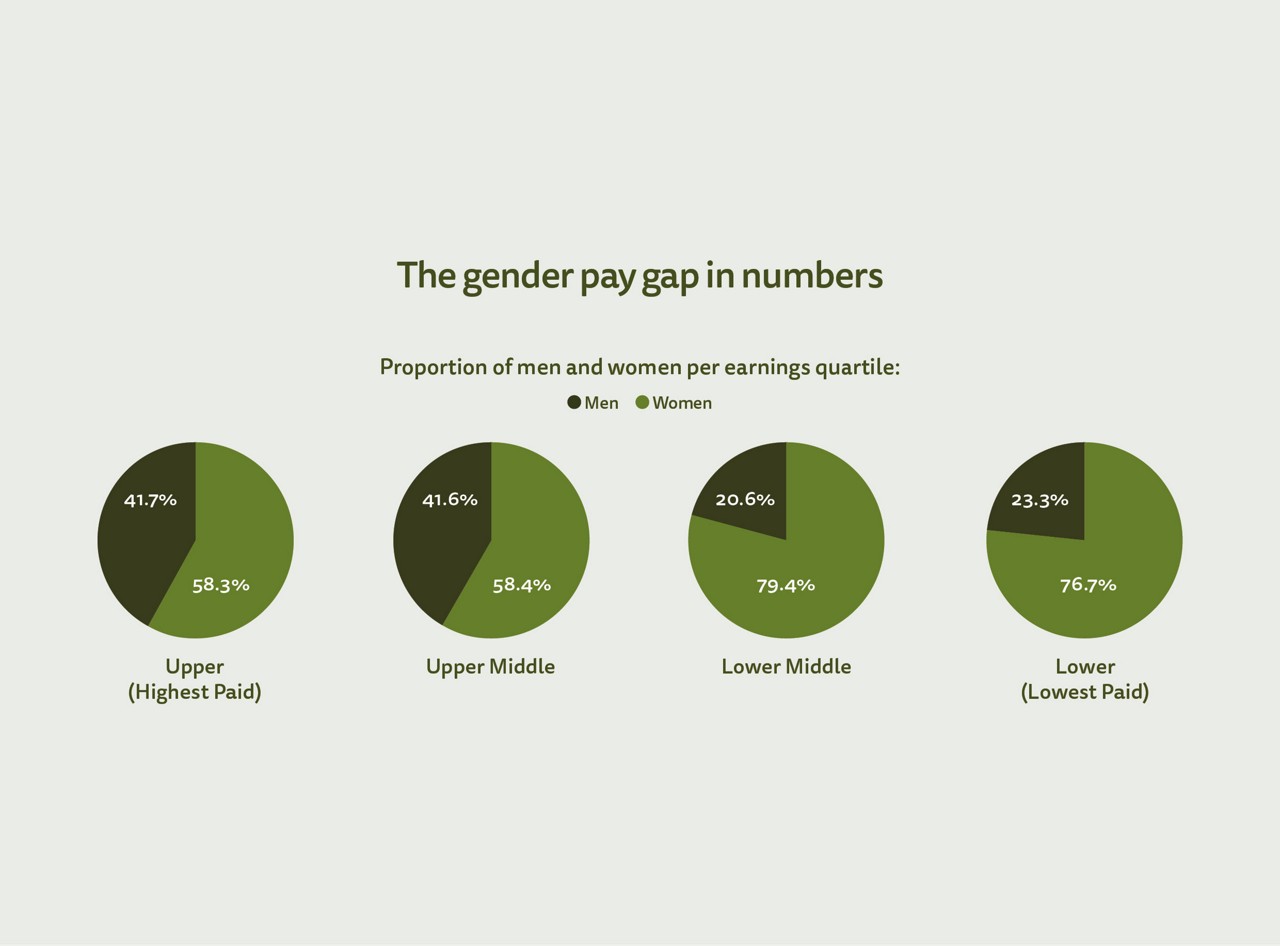UK Gender Pay Gap Report 2024
At Center Parcs, we are committed to encouraging our staff to grow to their very best and achieve their potential. We know the best way we can do this is to ensure that we treat everyone fairly and encourage progression for all. That’s why we take monitoring our gender pay gap very seriously and are taking action to improve it.
The gender pay gap at Center Parcs
The gender pay gap is the difference in the average hourly wage of all men and women across a workforce. This is different to equal pay, which ensures men and women are paid the same wage for equal or similar work – we offer equal pay and have done for many years. By monitoring the gender pay gap, we can better understand our own workforce and we are working to reduce the gender pay gap each year.
The median gender pay gap at Center Parcs UK is 5.3% (reduced from 7.0%) and the mean gender pay gap is 12.2% (reduced from 12.8%) - this compares to a mean gender pay gap in the UK of 7.7% (ONS November 2023).
We are pleased to see a reduction in our gender pay gap over the year, but we do still have further to go and are committed to improving this further.
We continue to ensure strong female representation at all levels of the business and our business continues to be a major employer of women in the areas in which we operate. We employ more women than men in all of our earning quartiles.
Understanding the gender pay gap at Center Parcs
We acknowledge that there is a gender pay gap in terms of hourly pay for women at Center Parcs.
Whilst we do have good representation of women in senior roles, demonstrated by more than half of the top two quartiles of earners being female, we do recognise that the gap itself is, in part, due to men within the business being more likely to hold senior roles.
Over the past year, we focused on several senior appointments of women within the business, including enhancing the gender diversity on our Operating Board with the appointment of our female Chief People Officer in January 2024.
We intend to continue these efforts with the appointment of a female Chief Marketing Officer, which will be further detailed in next years’ report.
As well as these specific appointments, we continue to support and nurture the careers of women within our organisation through various initiatives, including our International Women’s Day celebrations and the ongoing Women’s Development Programme, which fosters career progression for our broader female talent.
Our steps to reduce the gender pay gap
Some of the actions we have taken, and continue to roll out, include:
- Continuing our Diversity, Equity & Inclusion (DE&I) journey with the appointment of a DE&I Manager, who will help us launch a formal strategy to embed various initiatives across our business. This role will enable us to take a more strategic and focused approach to improving gender equality and addressing the pay gap.
- To further support this work, all of our staff have completed DE&I training this year, enhancing awareness and education on key topics impacting gender equity, such as unconscious bias and gender stereotypes.
- Adopting a more flexible approach to working patterns for current and future employees to attract and retain a diverse workforce.
- Introducing a menopause policy and working with colleagues across the business to support them during this stage of life. The policy aims to retain knowledge, skills and capability within our business, as well as removing potential barriers to individuals who want to continue progressing their career.
- Using transparent pay rates to ensure our pay gap is driven by the number of men and women at different seniority levels, rather than our pay structure.
- Continuing to run our annual Women’s Development Programme, delivering coaching and mentoring to our female employees and helping to progress our key talent.
The gender pay gap in numbers
Proportion of men and women per earnings quartile
 Figure 1: Pie chart showing the proportion of men and women per earnings quartile
Figure 1: Pie chart showing the proportion of men and women per earnings quartile
Upper quartile (highest paid)
Men: 41.7%
Women: 58.3%
Upper middle quartile
Men: 41.6%
Women: 58.4%
Lower middle quartile
Men: 20.6%
Women: 79.4%
Lower quartile (lowest paid)
Men: 23.3%
Women: 76.7%
The chart shows the proportion of men and women per earnings quartile for the four quartiles. There is a relatively even split across the upper quartiles (the highest paid). There are more women than men in the lower quartiles, with the highest proportion of women being in the lower middle quartile.
Hourly pay gap
These figures represent the amount less that an average female employee receives, compared with an average male employee.
Mean: 5.3%
Median: 12.2%
Bonus pay gap
Our bonus pay gap is mainly due to the fact that our bonus is liked to total annual salary. Our bonus pay gap is a higher figure for full-time employees and we can see that men are more likely to work full-time at Center Parcs than women.
Median: 47.0%
Mean: 68.0%
Statutory disclosures
The Center Parcs Group has three separate legal entities which employ more than 250 employees and that we are required to provide figures for. The numbers relating to these are as follows:
Center Parcs Limited
Mean: 15.8%
Median: 6.1%
Mean: 73.2%
Median: 45.5%
Men: 65.0%
Women: 68.4%
Upper quartile (highest paid)
Men: 41.2%
Women: 58.8%
Upper middle quartile
Men: 40.5%
Women: 59.5%
Lower middle quartile
Men: 18.1%
Women: 81.9%
Lower quartile (lowest paid)
Men: 20.2%
Women: 79.8%
Center Parcs (Operating Company) Limited
Mean: 6.1%
Median: 2.6%
Mean: 48.5%
Median: 48.9%
Men: 57.8%
Women: 60.5%
Upper quartile (highest paid)
Men: 48.4%
Women: 51.6%
Upper middle quartile
Men: 50.5%
Women: 49.5%
Lower middle quartile
Men: 29.0%
Women: 71.0%
Lower quartile (lowest paid)
Men: 34.5%
Women: 65.5%
CP Woburn (Operating Company) Limited
Mean: 6.7%
Median: 3.3%
Mean: 49.4%
Median: 49.4%
Men: 56.5%
Women: 63.5%
Upper quartile (highest paid)
Men: 37.4%
Women: 62.6%
Upper middle quartile
Men: 39.4%
Women: 60.6%
Lower middle quartile
Men: 22.6%
Women: 77.4%
Lower quartile (lowest paid)
Men: 22.3%
Women: 77.7%



